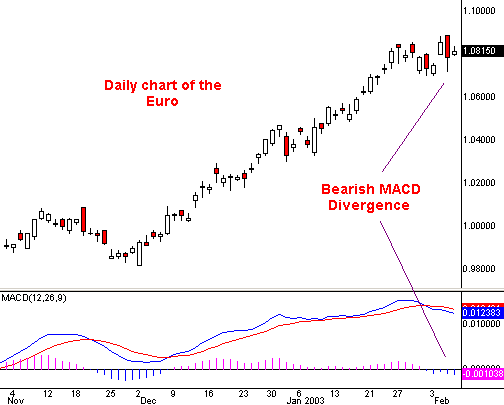Why There May Be Short-Term Strength In The Dollar
Editor’s Note: I am pleased to welcome Ed Allen as a regular
TradingMarkets contributor. Look for his commentary every day at 5:00 PM ET. — Brice
US News
Business productivity was down
.2% in 4Q02, reversing a 5.5% increase in 3Q. Jobless claims fell by
11,000 for the week to 391,000, keeping the four-week average at 385,000; readings
below 400k are usually associated with economic growth, though minimal in this
current setting. Retailers posted January sales at the low end of expectations
but raised their forecasts due to cost efficiency. The anemic economic growth
will continue as long as corporate and geo-political uncertainty is resolved.
Equities
The S&P 500 was down 5.44(.64%) to
838.15, led by Exxon Mobil and insurer, AIG. The
Dow was down 55.88(.69%) to
7929.30. The Nasdaq, the weaker index in
recent sessions, finished up .22 to 1301.72. Overall, expect some
consolidation around the current levels before the markets continue there
journey to the netherworld.
Fixed income
The Fed funds July contract is
pricing in a 36% chance of a 25bp cut, and according to the futures, no
tightening is expected until December. At this point, however, the onus for inducing an economic recovery is on fiscal policy and not on monetary policy.
Treasuries finished slightly up
on equity market weakness but cautious ahead of January’s payroll data due
tomorrow–the Street is looking for 65,000 jobs created, with the
unemployment rate flat at 6%.
2y + .02 to 99-30
5y + .08 to 100-10
10y + .13 to 100-14
30y + .23 to 108-20
Commodities
CRB down .21 to 247.44
Oil
down .23 to 34.16
gold down 6.5 to 370.70
Elsewhere in
the world…
Iraq
Turkey seems increasingly willing
to allow the US to use its bases to launch an attack on Iraq, making life easier
for American military planners. England’s Blair expressed
confidence today that a second UN resolution would pass.
Europe
In a surprise move, the Bank of
England cut its base rate by 25 bps to 3.75%, causing the FX markets to sell the
pound against all the major currencies, especially against the euro and Swiss
franc, as the interest rate differentials between the economies narrow.
The European Central Bank also
met today but kept rates steady at 2.75%. Economic data out of the mainland was
quite dismal, however, as German manufacturing orders were down 4.1% — the
biggest drop since 1995. An interesting point about this decline came from the
8.7% decline in exports, which can be attributed to the quick appreciation in
the euro against all of its trading partners. Although a strong currency helps
keep import prices down, it makes exports more expensive. And, since Europe’s
manufacturing sector is much more dependent on exports for overall GDP growth,
its economy will suffer as long as its currency continues to appreciate at such
a torrid pace.
The euro should continue to appreciate over the medium to
long-term time horizon, as economic weakness coupled with cheaper imports
(especially US-dollar-denominated oil) should keep real interest rates attractive
relative to those in the rest of the developed world. Technically, however, the
currency looks set for a correction. There is a bearish divergence occurring on
the daily charts where the price action is making higher highs while the MACD
has crossed to a sell.

